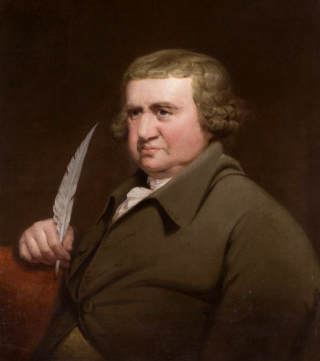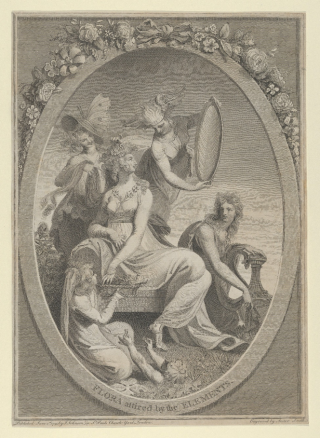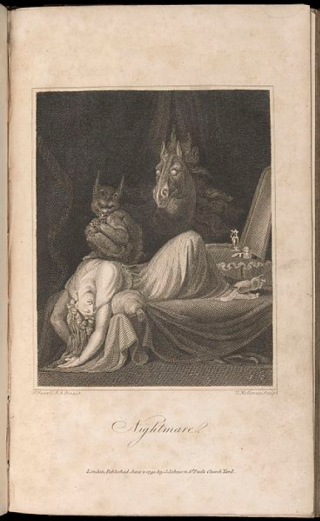Celebrating National Poetry Month with Erasmus Darwin’s ‘The Botanic Garden’
Posted in From the Library on April 24 2019, by Stephen Sinon
Stephen Sinon is the William B. O’Connor Curator of Special Collections, Research & Archives, of the LuEsther T. Mertz Library at NYBG.

The Botanic Garden, published in 1792, is a set of two poems, “The Economy of Vegetation” and “The Loves of the Plants,” both written by Erasmus Darwin (1731–1802); grandfather of the more famous Charles Darwin (1809–1882). The first celebrates technological innovation, scientific discovery and theory. The second and more popular poem promotes and explains the Linnean system of plant classification.
One of the first popular science books, the intent of The Botanic Garden was to pique popular interest in science. By embracing Linnaeus’s sexualized language, Darwin intended to make botany interesting and relevant to the readers of his time. While many Englishmen of the time were scandalized by the sexual nature of Linneaus’ taxonomic system, Darwin openly embraced it, using suggestive images in his floral descriptions, writing of blushing virgins, handsome swains, and deceitful paramours.
He emphasized the connections between humans and plants, arguing that they are all part of the same natural world and that sexual reproduction is central to evolution. His attempt to convey the wonders of scientific discovery and technology through poetry helped create a tradition of popular science writing which continues today.

The Botanic Garden is one of the most offbeat and unusual publications in English literature, yet it was a popular success. It not only reflected the spirit of the Enlightenment, scientific experimentation and optimism, but also offered a rich source of images and ideas for the rising Romantic poets such as Shelley, Coleridge, and Wordsworth, all of whom were inspired by it.
Darwin even described his plan to change the world’s climate via iceberg destruction. He was essentially correct in his assertion that the technologies of the Industrial Revolution could be used to change the climate of the globe.
The work was issued by the radical publisher Joseph Johnson. He was called “the most important publisher in England from 1770 until 1810” for his appreciation and promotion of young, innovative writers; his emphasis on publishing inexpensive works directed at a growing middle-class readership; and his cultivation and advocacy of women writers at a time when they were viewed with skepticism.
In the “Economy of Vegetation,” Darwin boldly set out to chart progress from elemental chaos to the modern world. The poem explodes into life with a vision of the creation of the universe, presaging the “Big Bang” theory. Beginning with the formation of the earth, he goes on to discuss electricity, steam power, photosynthesis, air pressure, oxygen, and even flying machines while looking forward to a time when adventurers will “journey beneath the ocean in large inverted ships.”

The insistence on the non-divine, self-regulating economy of the natural world—implied in the title “The Economy of Vegetation”—was most disturbing at the time. Genesis is replaced with a pagan version of Creation, redolent of the French philosophers and imbued with sex. Nobody had so far formulated a theory of the development of life free from the guiding hand of the Creator. Erasmus’ new theory of biological evolution was written some 70 years before his grandson Charles would publish his own groundbreaking work, On the Origin of Species by means of natural selection.
As the French Revolution became more savage, a rising backlash in England called into question Darwin’s views. In 1794, a wicked parody, “The Loves of the Triangles,” was published, claiming to show that humanity had risen from the cabbages of the field. Soon after this, poetic taste turned against him. Coleridge himself would eventually write in 1796, “I absolutely nauseate that poem.”
Later editions of The Botanic Garden included Fuseli’s startling composition, The Nightmare—a woman stretches across a bed while an apelike figure crouches on her chest and a ghostly horse with glowing eyes and flared nostrils emerges from the shadowy background. The engraving in the book is a reverse composition of the original painting which offers a highly personal vision exploring the dark, irrational forces of nature, dreams, and the unconscious.
For more information about Darwin’s Botanic Garden poem, explore Poetic Botany, a project by former NYBG Humanities Institute Mellon Fellow Ryan Feigenbaum.

